Nods to the automotive sector in the Basque Country
The new Car Exhibition at the Guggenheim Museum in Bilbao is one of the best I’ve ever seen. It very successfully unites life and art, the everyday and the aesthetic, technique and perfection. The automobile as an artistic cult object, in this case, is exposed in its proper dimension. Y is the center and thread of the sample..
I was pleasantly surprised by how fine art interweaves with car design and with the socio-economic life that this way of moving has imposed on us to live and travel the world. Architecture, sculpture, painting and cinema are very present; and with less weight music, literature and dance. In addition, the role that nature, society, economy, politics, the environment and the world’s technological development have played in the design of cars is subtly integrated.
The selection of an Car Exhibition as the star theme to celebrate 25 years of the Guggenheim Museum in Bilbao is also a success without any doubt. Moreover, I am almost certain that it has been intentionally decided not only for its universal interest, but also for its local prestige. The automotive sector represents around 20% of the Basque Country’s GDP. In its territory is produced the famous Vito, Viano and V-Class model van factory of the German firm Mercedes Benz Group in Vitoria-Gasteiz. And as local representatives we have: the Irizar Group in Ormáiztegui, internationally known for its high-end buses and coaches; and the firm belonging to the CAF Group called Solaris Bus & Coach, European leader in innovative buses, trolleybuses and urban rail vehicles. The Basque region has a long industrial tradition dating back to the 18th century, which is why it has developed an important auxiliary automotive industry with a high technological level and reliability.
Beginnings of the automotive industry (since combustion engines)
The first room of the exhibition, called Beginnings, shows us 8 cars corresponding to the beginnings of the automotive industry with a combustion engine, and some other hybrid or electric cars of the time. According to the organizers “this exhibition could be seen as a requiem for the last days of combustion.”
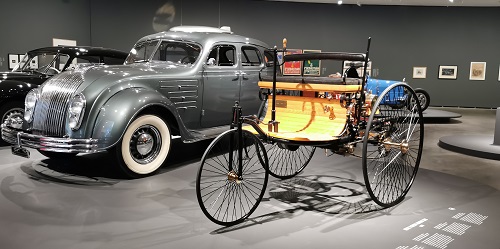
Horseless carriage. Benz. Patent 1886
From the moment I walked through the main door, I got a real lift, which I didn’t get over until an hour after leaving the museum. There was, in front of me, one of the official replicas of the “first car in the world and the first to be produced in series“, designed by Carl Benz. His patent was applied for on January 29, 1886 as a “vehicle propelled by a gasoline engine”. I could’nt believe it! I didn’t need the time machine to see myself driving hand in hand with Bertha Benz in this three-wheeled “horseless carriage” through Mannheim in Germany, while other people continued to see the exhibition.
I don’t know how I turned around and stayed in my virtual world when I saw an electric car from the year 1900! The Electrified Phaeton NR.27 designed by Porsche and Lohner powered by 4 electric motors integrated into the wheels of the car. And emission free! I immediately woke up wondering what the world would be like today if this technology had been the most viable. I finally concluded that today’s world would be different, although we will never know if it would have been better or worse.
If you want to take advantage of the exhibition, don’t just stay enjoying these car jewels, look at the Andy Warhol found on its walls, some study photos of the movement of a rider or an athlete, the sculptures of Brancusi of the fish and that of the bird, and other additional information that will make you better understand the interrelation between art and the automotive industry. In this room, the 1925 Voisin C7 Lumineuse car designed by Gabriel Voisin and others is an example in itself of the integration of the automotive industry with aviation, with the flourishing new architecture of the time of Le Corbusier (who drove this model for 3 years) and with the fashion of Coco Chanel.
I felt that I had already returned from my virtual trip through Germany, but I was still in the beginning of the 20th century, but in Bilbao. I am in a parking lot in front of the Arriaga Theater, watching a tram crash painted by Antonio de Guezala y Ayrivié from Bilbao. In addition, I am between a Ford T Tourer and a Rolls Royce 40/50 Alpine Eagle, so I mentally moved to Torre Loizaga (owner of this Ford) which is close to Bilbao and where you can see the most complete collection of Rolls- Royces of Europe. A place that I highly recommend visiting to all car lovers.
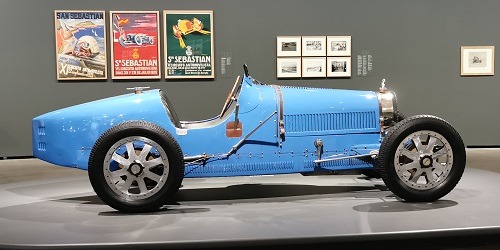
Bugatti type 35
I was delighted to find some topics on the automotive sector in the Basque Country in this Car Exhibition at the Guggenheim Museum in Bilbao. In front of the Bugatti type 35 designed by Ettore Bugatti, I found new national stories. This model was built for the French Grand Prix in Lyon in August 1924. It was driven by Ferdinand de Vizcaya in the San Sebastián Grand Prix in September 1925, and classified then in 5th place. There is a photo of that day on the wall of the expo, along with others from the Lasarte car circuit. Fernando, son of the Bilbao baron Agustín de Vizcaya, was a Spanish driver for the Elizalde Catalan cars before moving to the Bugatti team. Arturo Elizalde y Rouvier was a Cuban descendant of French Basques who is a pioneer of the Spanish automotive industry. You can also see 3 color lithographs on paper of the posters for the Spanish Grand Prix of 1927, 1928 and 1935 at the San Sebastián motor racing circuit.
As I looked at the other cars on display, and before leaving this first room, I missed a Basque car. I remembered the Ardiurme, an electric car designed by ARtiñano DIaz and HURtado de MEndoza (from where the name comes from). Equipped with two electric motors, each acting on one of the rear wheels. The motors had a system analogous to the one that, with good results, was built by the Deusto company “La Maquinista Bilbaína” for electric trams. And they were famous because they were the only ones at the time who could climb the steep slope of the Church of Begoña, the patron saint of the city. Also in those early stages the Hispano-Suiza (you can see one of them in this first room) or the Elizalde were the most recognized Spanish brands.
Sculptures on the roads
In the second room we find 20 pieces that we can combine in a single concept: sculptures, as they have named it. There are 4 cars, 2 large artistic sculptures and 14 small sculptures. The presence of Alexander Calder’s aerial sculpture January 31 is perfect for linking its “incessant and graceful movement” with that offered by these cars, especially the Delahaye Type 165 just below it. However, as if searching for its antagonism, Henry Moore’s bronze sculpture, Reclining Figure, reminds us of the robustness and compactness, and the relationship of volume with space that can also be present, in general, in automobiles. In addition, 14 statuettes, 12 of them by René Lalique and 2 by Rembrandt Bugatti, help us outline how the study of their shapes influences the adjacent designs.

Delahaye Type 165
The engineer Delahaye, who was a manufacturer of trucks, motorboats and industrial equipment, had already died when Jean François designed the red 165 model that we see at this expo. The brand hires Figoni et Falaschi, who built custom bodies for Delahaye, Bugatti, Renault, Delage, Panhard, Alfa Romeo and others. In this car we see in Italian style goccia d’acqua (“drop of water” or “tear”) that suggests us to see the car in constant movement. I would have liked to see next to this car a model dressed by the Basque couturier Cristóbal Balenciaga, just as Figoni et Falaschi did in those times. They saw themselves as a group of “true car body seamstresses“. I have more stories about this car, but I’ll tell you if you invite me to see together the Car Exhibition offered by the Guggenheim Museum in Bilbao.
Although 208 units, of the Bentley R-Type Continental have been made, including the prototype, each one of the units was customized. For automotive lovers, it is a cult car, as it broke speed records through the use of new prevailing techniques such as the use of the wind tunnel with 1.4 scale clay models (see some models in the corridor at the exit of this room) and the aluminum bodywork. In 2015, an unrestored car of this model sold for more than $1 million. Without a doubt, it is the car that I most associate with the statue of Henry Moore because of its roundness, and I can’t think of dressing this bronze “girl” in a Balenciaga dress (in case anyone thought of it).
The Bugatti type 57S Atlantic was named after its designer Jean Bugatti to honor his friend the aviator Jean Mermoz, who was the first to fly over the South Atlantic. I really like the color of it, its two “suicide doors” that open backwards, its elongated nose, and all the visible rivet seams both on the wheels and on its back (that reminds me of the Titanic). Undoubtedly, the British banker Victor Rothschild had good taste when he bought this first car, but in black, like the following 3. The second of the 4 built, the one that belonged to Jean, has not been located since the year of his death, making it one of the most sought-after treasures in the automotive industry. The third model was destroyed in a level crossing. And the last one built is today owned by the designer Ralph Lauren, which reinforces the idea that there is a lot of good sewing in the automotive industry. I think that the rivets on the car are a beautiful way of sewing.
Red, grey, blue and now a yellow car?! And with redwall tires. It definitely has to be Spanish. He has always believed that the Spanish brand Pegaso was for trucks and buses, and I found this beautiful Pegaso Z-102 Cúpula car from 1952. Every day you learn something new, and with this car I had to learn more than one thing. If you look closely, the Spanish Pegasus does not have wings, but it has flown across the Atlantic to the Americas and returned to Europe, and it is only almost 70 years later that it returns. We had not seen it in Spain because it was sold directly to Dominican President Trujillo at the New York Motor Show in February 1953. After an American tour of Puerto Rico and the US, with a Mexican owner included, it returned to Europe. First in the hands of a German collector for the Museo Rosso Bianco, near Munich. In 2006 the Louwman Museum in The Hague, Holland, bought it and repaired it for 6 years.

Pegaso Z-102 Cúpula
At the Villa d’Este Concorso d’Eleganza in 2015, the Pegaso Z-102 Dome won the BMW Group Ragazzi trophy, which is awarded by the vote of those under 16 years of age. And in 2016 it won Best in Show at the Amelia Island Concours d’Elegance in the US and Car of the Year at the prestigious Historic Motoring Awards in London. Although still remains without wings, it continues flying. The design work of the Catalan Wilfredo Ricart and his team of collaborators have finally recovered their moment of glory. It is also an international recognition of the Spanish automotive sector, especially the Catalan one. For this reason, and speaking of fashion, I already see the yellow of this sculptural Pegasus more dressed in gold.
Popularization of the private car
When you enter through the door of the third room of the Car Exhibition of the Guggenheim Museum in Bilbao, take a general look. You will recognize a Volkswagen Beetle, a Fiat Nuova 500, a Citroën 2CV «Sahara», a Renault 4 and The Mini. Without a doubt, you will not need to read the name of the room: Popularization. It is as if we were in a parking lot from the 50s to the 70s, from the 20th century. Cars built for the middle classes, as a sign of post-war times and modernity. Not always accessible to all social classes.
Another very common mistake, especially during the Franco era in Spain, is to think that there were only Seat 600 and nationally manufactured cars. In Spain, the first registered vehicles were foreign brands Clement, Tourneau, Berliet, Benz, Dion Bouton, Peugeot, Oldsmobile, Mercedes, Opel, Ford… and Spanish brands such as Hispano-Suiza, Elizalde and E. de la Cuadra. In the Basque Country, the first car was registered in 1901, a Renault. In Bilbao it was a Delahaye in 1902, and a Fiat in Vitoria-Gasteiz in 1906. And since then, the automobile fleet that has traveled the Spanish roads has always been very varied in European, American and local brands.
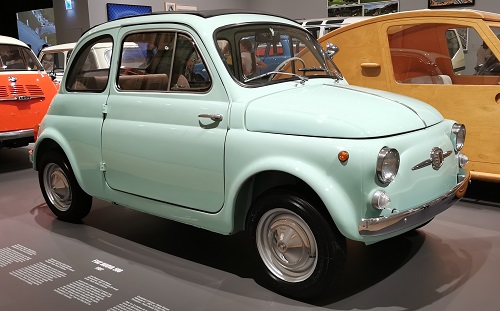
Fiat Nuova 500
The first car factories in Spanish territory appeared from the 1950s. SEAT as a subsidiary of FIAT, and FASA to manufacture Renault since 1953. The Renault 4CV or 4/4, is the first nationally manufactured utility vehicle mass-produced in Spain. Factories for Land Rover SUVs have been established in Jaen since 1956. Citroën began in 1957 with its 2CV model vans and then the sedan (which you can also see at the expo in its two-engine version). The Chrysler Corporation has manufactured, under its name, since 1969 in Spain; although with Barreiros Chrysler’s Simca and Dodge brands were already manufactured. And since 1967 the manufacture of English Morris cars in Spain by AUTHI begins, and the Mini since 1968 (also present at this expo). Of course, many of these brands were already being sold or were rolling on Spanish roads before these factories were established. From the 70s onwards, other international brands have opened factories in Spain like: Ford, General Motors, Peugeot,…
And when does Mercedes Benz enter Spain as a manufacturer? Roughly speaking, since 1948 the Catalan company Eucort Automobiles has been manufacturing cars and vans with a two-stroke engine oriented towards the German DKW. When going into suspension of payments, a majority group of Basques and some Catalans created IMOSA, and in 1951 they moved the manufacturing workshops to the Basque city of Vitoria-Gasteiz. The new plant began to produce in 1954. Initially, the components that arrived from Germany were assembled, and they were immediately replaced with national elements. They became so famous that a DKW (decauve) became a term to designate any truck in Spain, although originally few know what it means “steam-powered car” and more related to motorcycles and cars. The vans were built with DKW’s own three-cylinder brand engines, and from 1958 they were built with Barcelona-made Mercedes diesel engines. Finally, in 1975 they left the factory with the designation of Mercedes-Benz. And the company takes full control in 1981. These and other stories I tell you in more detail in the personalized and private tours that I do in the Basque Country.
VW, for its part, presented its cars for the first time in Spain in 1952 at the Barcelona Fair. Its first sales are monopolized by military personnel, diplomats, resident foreigners or the upper class. Although this brand means in German, people’s car. However, it is the brand that has been manufactured for the longest time and the one that has produced the most units in the world. Specialists include it among the 5 most influential cars of the 20th century. Although the Beetle was considered a cult car, it was never manufactured in Spain. Until 1984 it was not possible to manufacture a VW in Spain. And they continue, today as VW Navarra, in the Landaben Industrial Park, in Pamplona (the VW Group sponsors this exhibition). There were several attempts before installation in Pamplona, two of them related to the Basque Country. The suppliers of gearboxes for DKW vans, the Biscayan industrial group Beltrán, Casado y Compañía, contacted VW in 1954 to obtain a manufacturing license. The Spanish administration aborted this action. And it was also allowed to be negatively influenced by national competitors in another possibility launched in 1966. This time, it was VW’s own parent company that requested to manufacture on IMOSA’s land and facilities in Vitoria-Gasteiz.
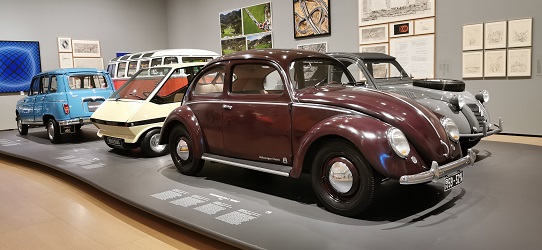
Volkswagen Type 1 Beetle
The Electromechanical Precision Workshops Beltrán, Casado y Cía. continued to try to obtain a German manufacturing license, after the unsuccessful one with VW. They reached an agreement in 1957 with the German company Hans Glas GmbH to manufacture a microcar that was already successful in Germany, the Goggomobil. In 1962 the first car left its facilities in Mungia, Basque Country. Whoever was the best manufacturer of refrigerators (Frisan brand) in Spain created the company Munguía Industrial, S.A. (MUNISA) to manufacture cars, based on its long industrial experience. As many companies have also been converted in the Basque Country during periods of crisis. The price of about 300 euros for the Goggomobil, compared to the approximate 480 euros for the Seat 600, was enough to stay in the market. Until the difference with the Seat 600 was only 60 euros, and the factory closed in 1969.
Of course, the art in the Car Exhibition at the Guggenheim Museum in Bilbao is also felt in this Popularization room. I recommend you not to miss the opportunity to see in this room, 2 of Norman Foster’s plans for the Bilbao Metro and the “Fosterito“. Not to be missed is the red logo design for the Bilbao Metro by a member of Foster’s team named Otl Aicher. In addition, the Basque artist Maider López presents us with a video and 5 photographs, made in 2015, called: Jam.
Look at the wooden prototype of 1936, the Voiture Minimum by the architect Le Corbusier, and the perspective study sketches or side and front elevation of it. Or Alberto Giacometti’s sketches with themes from the streets of the city. Around this time Mary Quant, the British fashion designer, named her short skirt a miniskirt in allusion to the fashionable car: the Mini. André Courrèges, a disciple of the Basque Balenciaga, combined the miniskirt with high boots. And, among other couturiers, Coco Chanel described it as horrendous.
The automotive industry not only revolutionized speed, it also revolutionized ideas and consciousness. Remember that in the 1960s, the VW Type 2 Microbus Deluxe “Samba” minibus and also the Beetle, were adopted as a symbol of the hippie movement. And the mini-skirt.
If you want to go with me to this exhibition or do a private and personalized tour of Bilbao, contact me.
Note: I am very grateful for the review of this text by Miguel Martín Zurimendi, a researcher in the history of the automotive industry.
Second part on the Car Exhibition at the Guggenheim Museum in Bilbao.


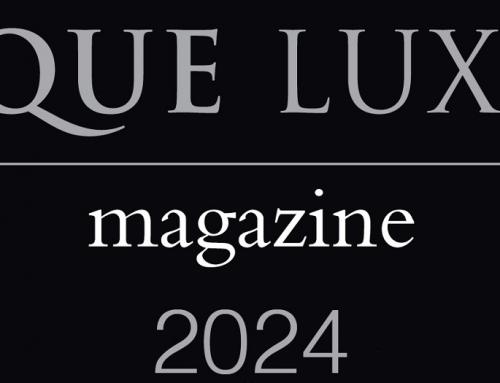
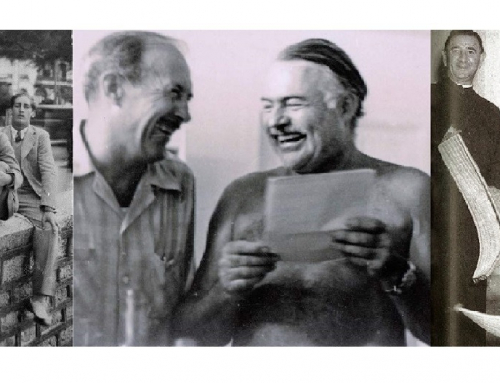
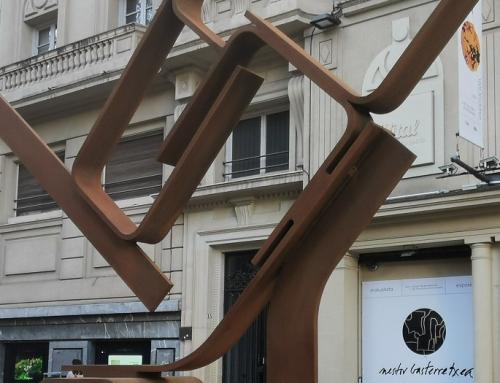
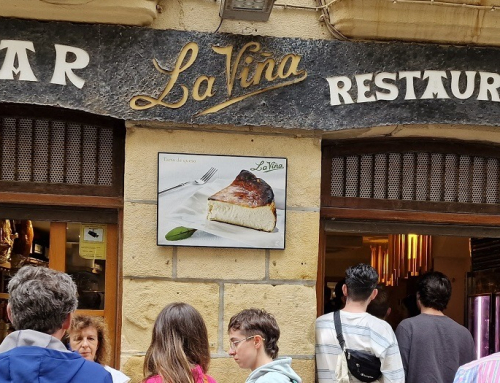



Leave A Comment